Assessment of Stoplog Gates’ Operational Effectiveness for Improving Discharged-Water Temperatures during the Thermal Stratification Period in a Reservoir
Abstract
1. Introduction
2. Materials and Methods
2.1. Study Area
2.2. Overview of the Stoplog Gate
2.3. Selective-Water-Withdrawal Test
2.4. Statistical Analysis and Stratification Index
2.4.1. Stratification Index
2.4.2. Statistical Analysis
3. Results and Discussion
3.1. Data Analysis
3.1.1. Processes of Thermal Stratification
3.1.2. Process of the DWT
3.2. Correlation Analysis
3.3. Evaluation of Selective Withdrawal Effects
3.4. Optimization of the Stoplog-Gate Scheduling
4. Conclusions
- (1)
- The water-temperature distribution in the reservoir area of GZ showed a stable stratification structure during the test period, and the stratification intensity gradually strengthened. The SI varied between 109.36 kg/m2 and 446.85 kg/m2. The DWT of the drainage channel with 3–5 layers of stoplog gates was 1.4 °C higher than that of the drainage channel with the original bottom water inlet, with an average increase of 0.6 °C. This shows that the stoplog gate plays an important role in mitigating the adverse effects of water temperature in GZ.
- (2)
- We proposed EEM to evaluate and analyze the stratified-water-intake effect of the stoplog gate and analyzed and demonstrated it based on the observation data in the stratified-water-intake test of the GZ. The stratified-water-intake effect is reflected by the water-intake elevation or the water-intake-layer range. For example, the water-intake layer range of the 4-layer stoplog gate is 689.8 m–691.7 m, and the average water-intake elevation is 690.8 m. The results show that this method is simple to use, can reflect the operation of the stoplog door, and has good practicability.
- (3)
- EEM is used to analyze the monitoring data to statistically interpret the average water-intake elevation or water-intake layer within a certain range of water-level changes when different layers of stoplog gates are operated, which has value as a reference for optimizing stoplog-gate scheduling.
Future Perspectives
Author Contributions
Funding
Data Availability Statement
Conflicts of Interest
References
- Yigzaw, W.; Li, H.; Fang, X.; Leung, L.R.; Voisin, N.; Hejazi, M.I.; Demissie, Y. A Multilayer Reservoir Thermal Stratification Module for Earth System Models. J. Adv. Model. Earth Syst. 2019, 11, 3265–3283. [Google Scholar] [CrossRef]
- Lugg, A.; Copeland, C. Review of cold water pollution in the Murray-Darling Basin and the impacts on fish communities. Ecol. Manag. Restor. 2014, 15, 71–79. [Google Scholar] [CrossRef]
- Moore, M.J.; Paukert, C.P.; Brooke, B.L.; Moore, T.L. Lake sturgeon seasonal movements in regulated and unregulated Missouri River tributaries. Ecohydrology 2022, 15, e2362. [Google Scholar] [CrossRef]
- Ren, L.; Song, C.; Wu, W.; Guo, M.; Zhou, X. Reservoir effects on the variations of the water temperature in the upper Yellow River, China, using principal component analysis. J. Environ. Manag. 2020, 262, 110339. [Google Scholar] [CrossRef]
- He, W.; Wang, H.; Zhang, J.; Xu, H.; Xiao, Y. Diurnal variation characteristics of thermal structure in a deep reservoir and the effects of selective withdrawal. J. Environ. Manag. 2023, 333, 117459. [Google Scholar] [CrossRef] [PubMed]
- Zheng, T.; Sun, S.; Liu, H.; Xia, Q.; Zong, Q. Optimal control of reservoir release temperature through selective withdrawal intake at hydropower dam. Water Supply 2017, 17, 279–299. [Google Scholar] [CrossRef][Green Version]
- Gao, X.; Li, G.; Han, Y. Effect of Flow Rate of Side-Type Orifice Intake on Withdrawn Water Temperature. Sci. World J. 2014, 2014, 979140. [Google Scholar] [CrossRef] [PubMed]
- He, W.; Lian, J.; Du, H.; Ma, C. Source tracking and temperature prediction of discharged water in a deep reservoir based on a 3-D hydro-thermal-tracer model. J. Hydro-Environ. Res. 2018, 20, 9–21. [Google Scholar] [CrossRef]
- Dehghan, A.A.; Dehghani, A.R. Experimental and theoretical investigation of thermal performance of underground cold-water reservoirs. Int. J. Therm. Sci. 2011, 50, 816–824. [Google Scholar] [CrossRef]
- Song, Q.; Sun, B.; Gao, X.; Liu, Y. Laboratory investigation on the influence of factors on the outflow temperature from stratified reservoir regulated by temperature control curtain. Environ. Sci. Pollut. Res. 2020, 27, 33052–33064. [Google Scholar] [CrossRef]
- Larabi, S.; Schnorbus, M.A.; Zwiers, F. A coupled streamflow and water temperature (VIC-RBM-CE-QUAL-W2) model for the Nechako Reservoir. J. Hydrol. Reg. Stud. 2022, 44, 101237. [Google Scholar] [CrossRef]
- Wang, H.; Deng, Y.; Yan, Z.; Yang, Y.; Tuo, Y. Thermal response of a deep monomictic reservoir to selective withdrawal of the upstream reservoir. Ecol. Eng. 2023, 187, 106864. [Google Scholar] [CrossRef]
- Çalışkan, A.; Elçi, Ş. Effects of Selective Withdrawal on Hydrodynamics of a Stratified Reservoir. Water Resour. Manag. 2009, 23, 1257–1273. [Google Scholar] [CrossRef]
- Zhang, S.; Gao, X. Effects of Selective Withdrawal on Temperature of Water Released of Glen Canyon Dam. In Proceedings of the 2010 4th International Conference on Bioinformatics and Biomedical Engineering (iCBBE), Chengdu, China, 18–20 June 2010; pp. 1–4. [Google Scholar] [CrossRef]
- Huang, L.; Wang, J.; Zhu, L.; Ju, J.; Daut, G. The Warming of Large Lakes on the Tibetan Plateau: Evidence From a Lake Model Simulation of Nam Co, China, During 1979–2012: Thermal Simulation in a Tibet Lake. J. Geophys. Res. Atmos. 2017, 122, 13095–13107. [Google Scholar] [CrossRef]
- Huang, T.; Li, X.; Rijnaarts, H.; Grotenhuis, T.; Ma, W.; Sun, X.; Xu, J. Effects of storm runoff on the thermal regime and water quality of a deep, stratified reservoir in a temperate monsoon zone, in Northwest China. Sci. Total Environ. 2014, 485–486, 820–827. [Google Scholar] [CrossRef]
- Zhang, D.; Wang, D.; Peng, Q.; Lin, J.; Jin, T.; Yang, T.; Sorooshian, S.; Liu, Y. Prediction of the outflow temperature of large-scale hydropower using theory-guided machine learning surrogate models of a high-fidelity hydrodynamics model. J. Hydrol. 2022, 606, 127427. [Google Scholar] [CrossRef]
- Vercauteren, N.; Huwald, H.; Bou-Zeid, E.; Selker, J.S.; Lemmin, U.; Parlange, M.B.; Lunati, I. Evolution of superficial lake water temperature profile under diurnal radiative forcing: Lake Temperature Profile Under Radiative Forcing. Water Resour. Res. 2011, 47, W09522. [Google Scholar] [CrossRef]
- Yang, P.; Xing, Z.; Fong, D.A.; Monismith, S.G.; Tan, K.M.; Lo, E.Y.M. Observations of vertical eddy diffusivities in a shallow tropical reservoir. J. Hydro-Environ. Res. 2015, 9, 441–451. [Google Scholar] [CrossRef]
- Chang, F.; Hou, P.; Wen, X.; Duan, L.; Zhang, Y.; Zhang, H. Seasonal Stratification Characteristics of Vertical Profiles and Water Quality of Lake Lugu in Southwest China. Water 2022, 14, 2554. [Google Scholar] [CrossRef]
- Yang, X.; Li, Y.; Wang, B.; Xiao, J.; Yang, M.; Liu, C.-Q. Effect of hydraulic load on thermal stratification in karst cascade hydropower reservoirs, Southwest China. J. Hydrol. Reg. Stud. 2020, 32, 100748. [Google Scholar] [CrossRef]
- Zhang, Y.; Wu, Z.; Liu, M.; He, J.; Shi, K.; Wang, M.; Yu, Z. Thermal structure and response to long-term climatic changes in Lake Qiandaohu, a deep subtropical reservoir in China. Limnol. Oceanogr. 2014, 59, 1193–1202. [Google Scholar] [CrossRef]
- Liu, M.; Zhang, Y.; Shi, K.; Zhu, G.; Wu, Z.; Liu, M.; Zhang, Y. Thermal stratification dynamics in a large and deep subtropical reservoir revealed by high-frequency buoy data. Sci. Total Environ. 2019, 651, 614–624. [Google Scholar] [CrossRef] [PubMed]
- Qi, C.J.; Lu, B.H. Study of the Temporal and Spatial Distribution of Water Temperature in Ertan Reservoir Based on Prototype Observation. Adv. Mater. Res. 2013, 864–867, 2278–2287. [Google Scholar] [CrossRef]
- Fu, J.; Li, J.; Rui, J.; Tang, Y. Raising discharge water temperature by using water-level-selection with stoplog gate. J. Tianjin Univ. Sci. Technol. 2014, 47, 589–595. (In Chinese) [Google Scholar] [CrossRef]
- Yan, Z.; Lu, J.; Wang, X.; Xu, H.; Chang, H.; Kuang, L.; Huang, Y. Analysis Method of the Influence of Layered Water Intake by Stoplog Gates on Discharge Water Temperature. Water Power 2023, 49, 6–9. (In Chinese) [Google Scholar] [CrossRef]
- Wang, Y.; Zhang, N.; Wang, D.; Wu, J. Impacts of cascade reservoirs on Yangtze River water temperature: Assessment and ecological implications. J. Hydrol. 2020, 590, 125240. [Google Scholar] [CrossRef]
- Xie, Q.; Liu, Z.; Fang, X.; Chen, Y.; Li, C.; MacIntyre, S. Understanding the Temperature Variations and Thermal Structure of a Subtropical Deep River-Run Reservoir before and after Impoundment. Water 2017, 9, 603. [Google Scholar] [CrossRef]
- Dake, J.M.K.; Harleman, D.R.F. Thermal stratification in lakes: Analytical and laboratory studies. Water Resour. Res. 1969, 5, 484–495. [Google Scholar] [CrossRef]
- Song, Q.; Sun, B.; Gao, X.; Zhang, C. PIV experimental investigation of the outflow temperature from nonlinearly stratified reservoir regulated by floating intake. Exp. Therm. Fluid Sci. 2019, 109, 109893. [Google Scholar] [CrossRef]
- Sahoo, G.B.; Forrest, A.L.; Schladow, S.G.; Reuter, J.E.; Coats, R.; Dettinger, M. Climate change impacts on lake thermal dynamics and ecosystem vulnerabilities: Climate change impacts. Limnol. Oceanogr. 2016, 61, 496–507. [Google Scholar] [CrossRef]
- Yang, Y.; Chen, M.; Deng, Y.; Schladow, S.G.; Li, J.; Tuo, Y.-C. Impact of climate change on thermal and mixing regimes in a deep dimictic reservoir on the Qinghai-Tibetan Plateau, China. J. Hydrol. 2021, 603, 127141. [Google Scholar] [CrossRef]
- Wang, L.; Xu, B.; Zhang, C.; Fu, G.; Chen, X.; Zheng, Y.; Zhang, J. Surface water temperature prediction in large-deep reservoirs using a long short-term memory model. Ecol. Indic. 2022, 134, 108491. [Google Scholar] [CrossRef]
- Wang, J.; Li, C.; Duan, X.; Chen, D.; Feng, S.; Luo, H.; Peng, Q.; Liao, W. Variation in the significant environmental factors affecting larval abundance of four major Chinese carp species: Fish spawning response to the Three Gorges Dam. Freshw. Biol. 2014, 59, 1343–1360. [Google Scholar] [CrossRef]
- He, W.; Ma, C.; Zhang, J.; Lian, J.; Wang, S.; Zhao, W. Multi-objective optimal operation of a large deep reservoir during storage period considering the outflow-temperature demand based on NSGA-II. J. Hydrol. 2020, 586, 124919. [Google Scholar] [CrossRef]
- Schneider, M.L.; Wilhelms, S.C.; Yates, L.I. SELECT Version 1.0 Beta: A One-Dimensional Reservoir Selective Withdrawal Model Spreadsheet; Defense Technical Information Center: Fort Belvoir, VA, USA, 2004. [Google Scholar] [CrossRef]
- Anohin, V.V.; Imberger, J.; Romero, J.R.; Ivey, G.N. Effect of Long Internal Waves on the Quality of Water Withdrawn from a Stratified Reservoir. J. Hydraul. Eng. 2006, 132, 1134–1145. [Google Scholar] [CrossRef]
- Fischer, H.B. (Ed.) Mixing in Inland and Coastal Waters; Academic Press: New York, NY, USA, 1979. [Google Scholar]
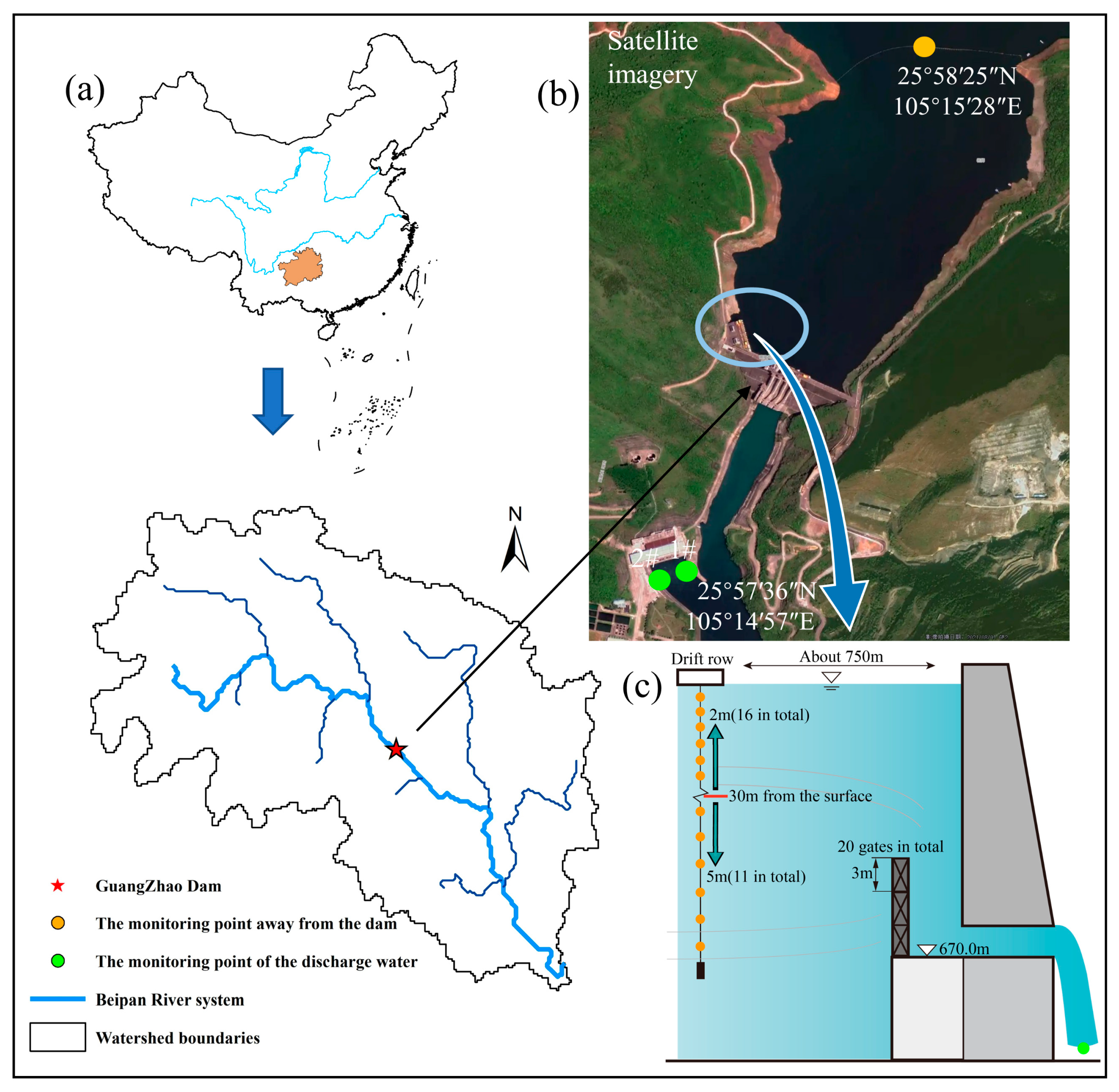
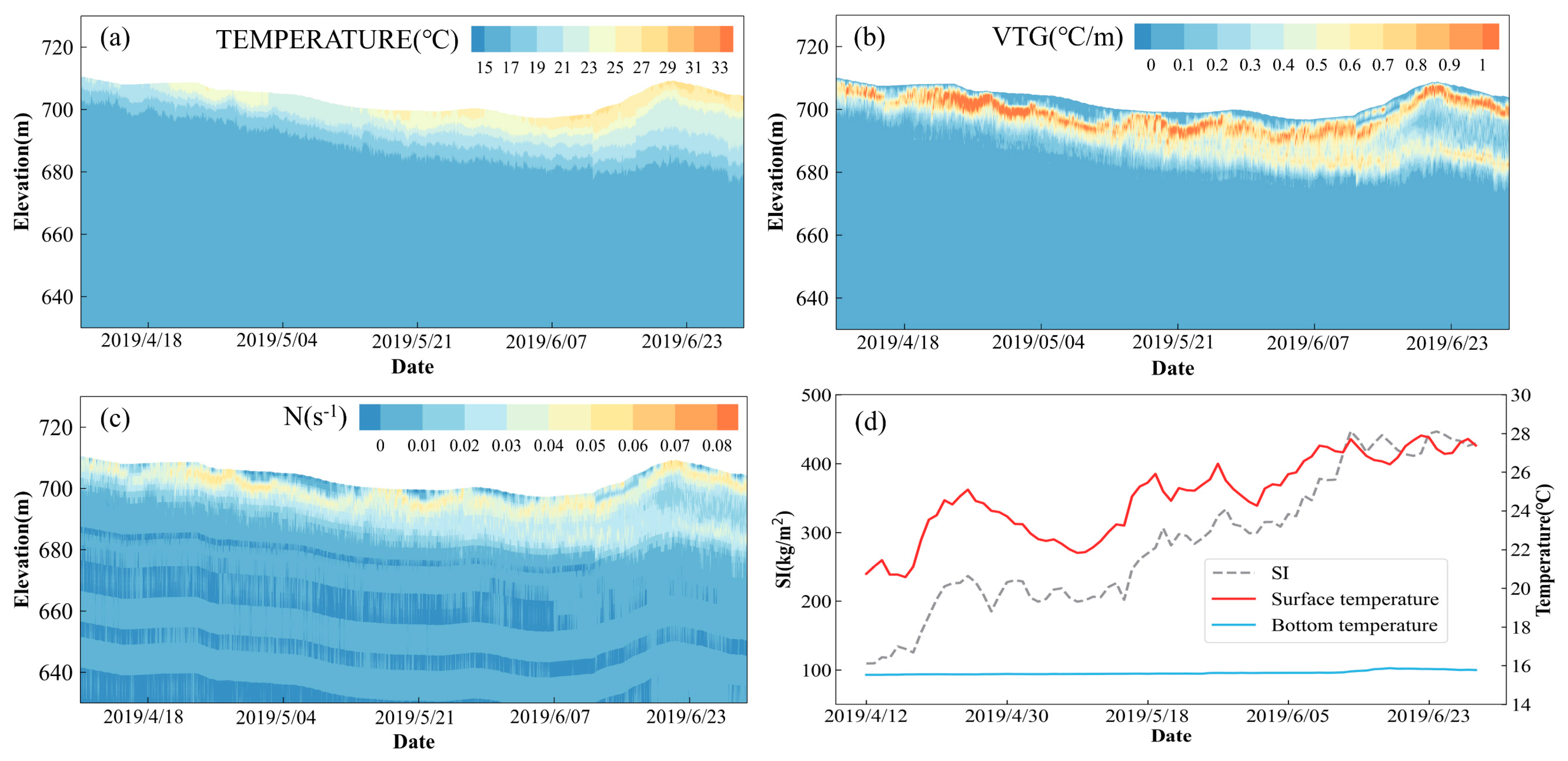
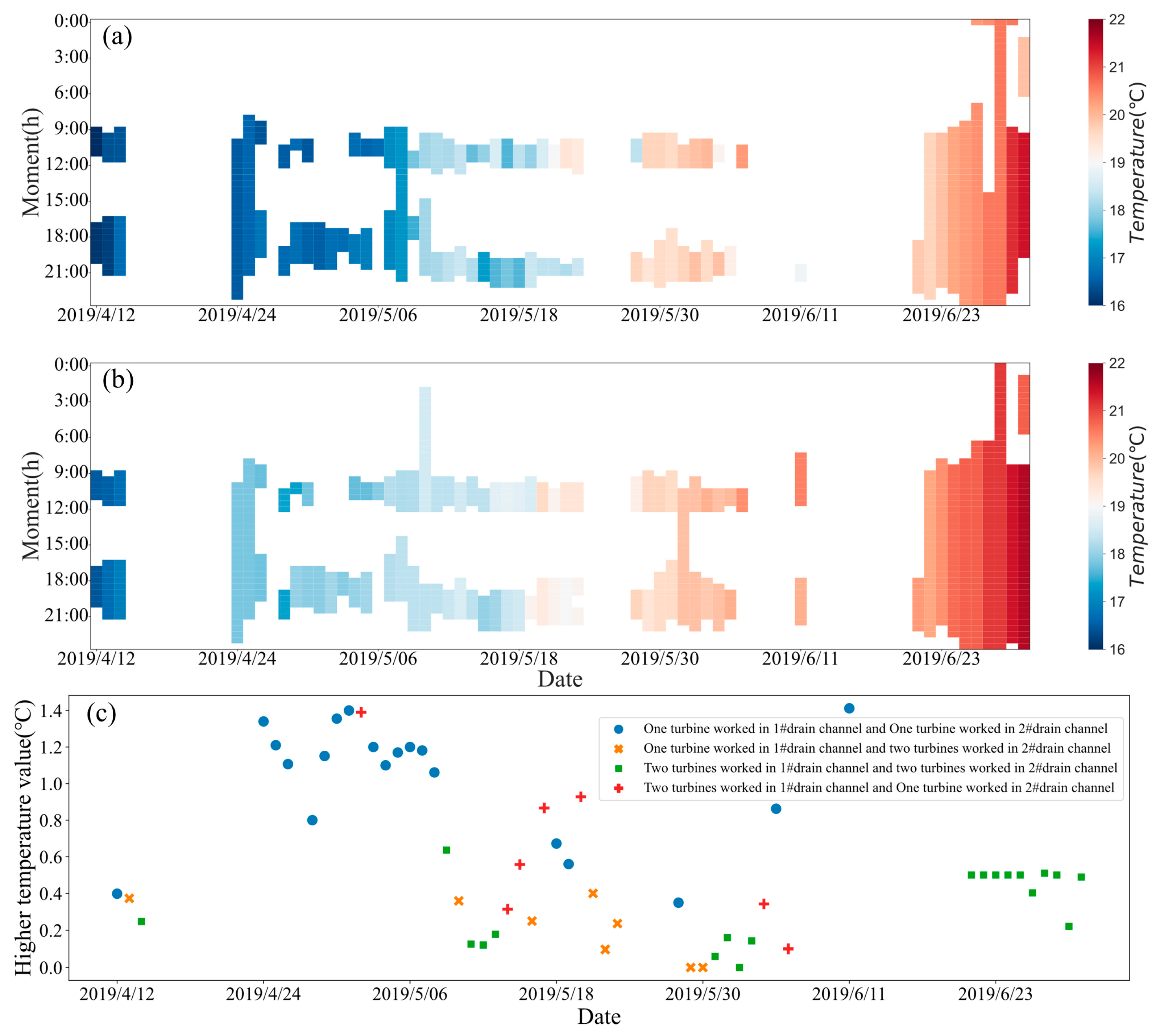
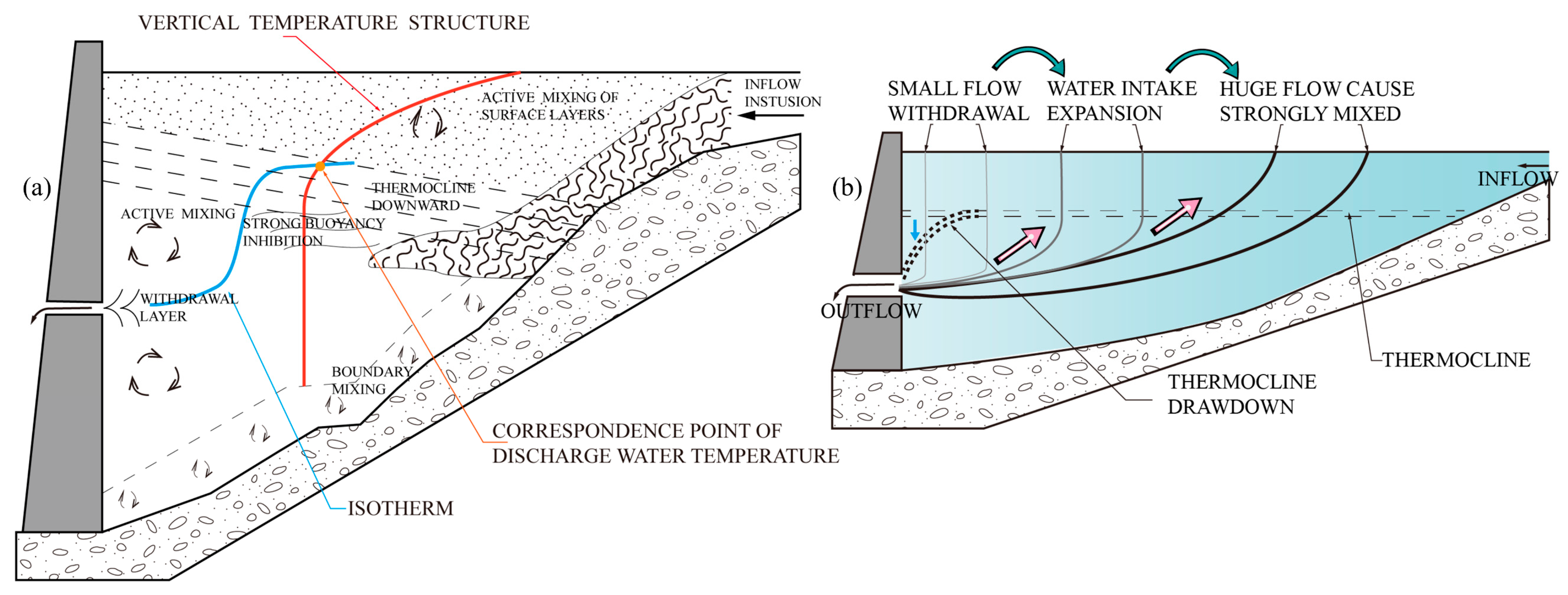
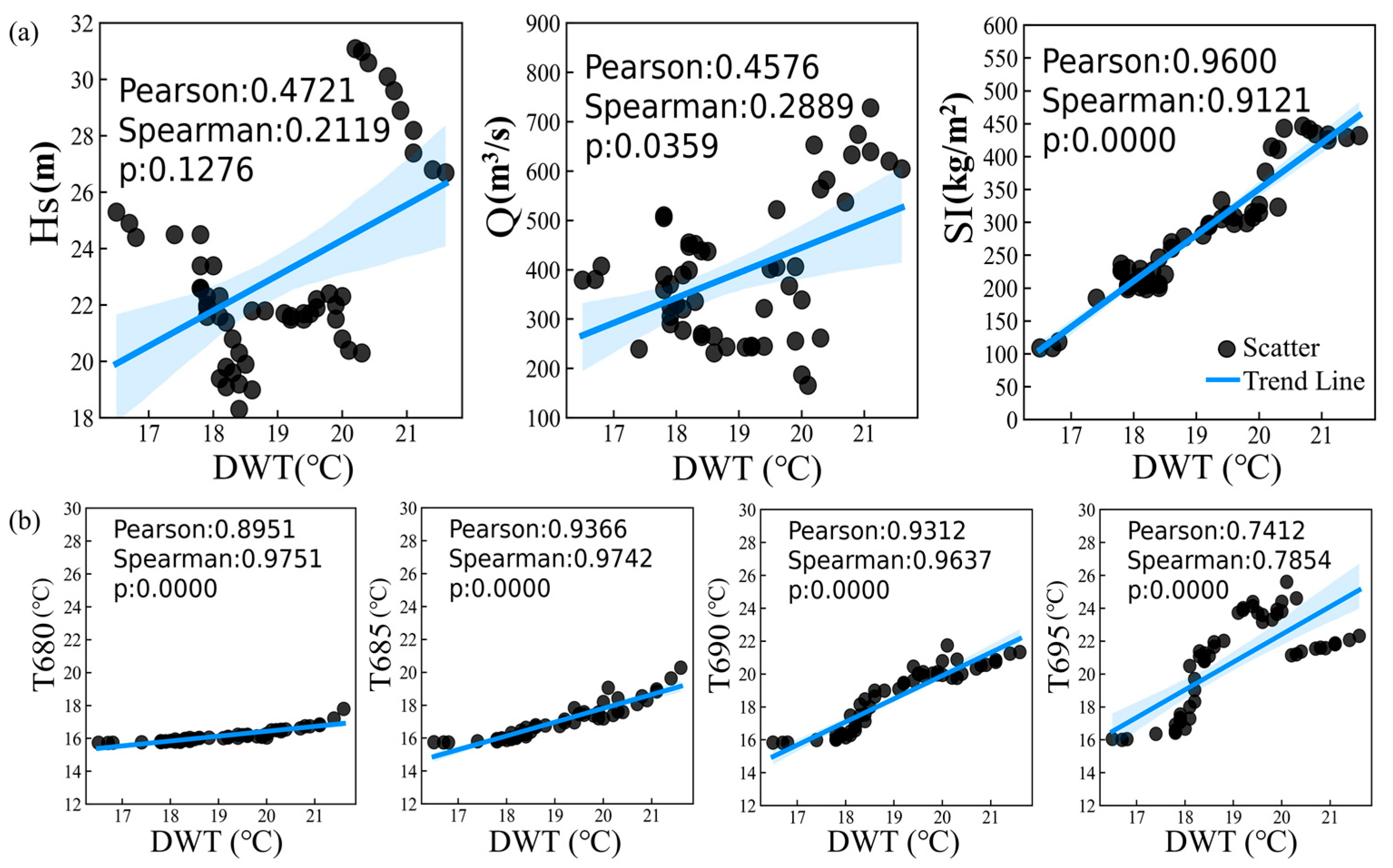
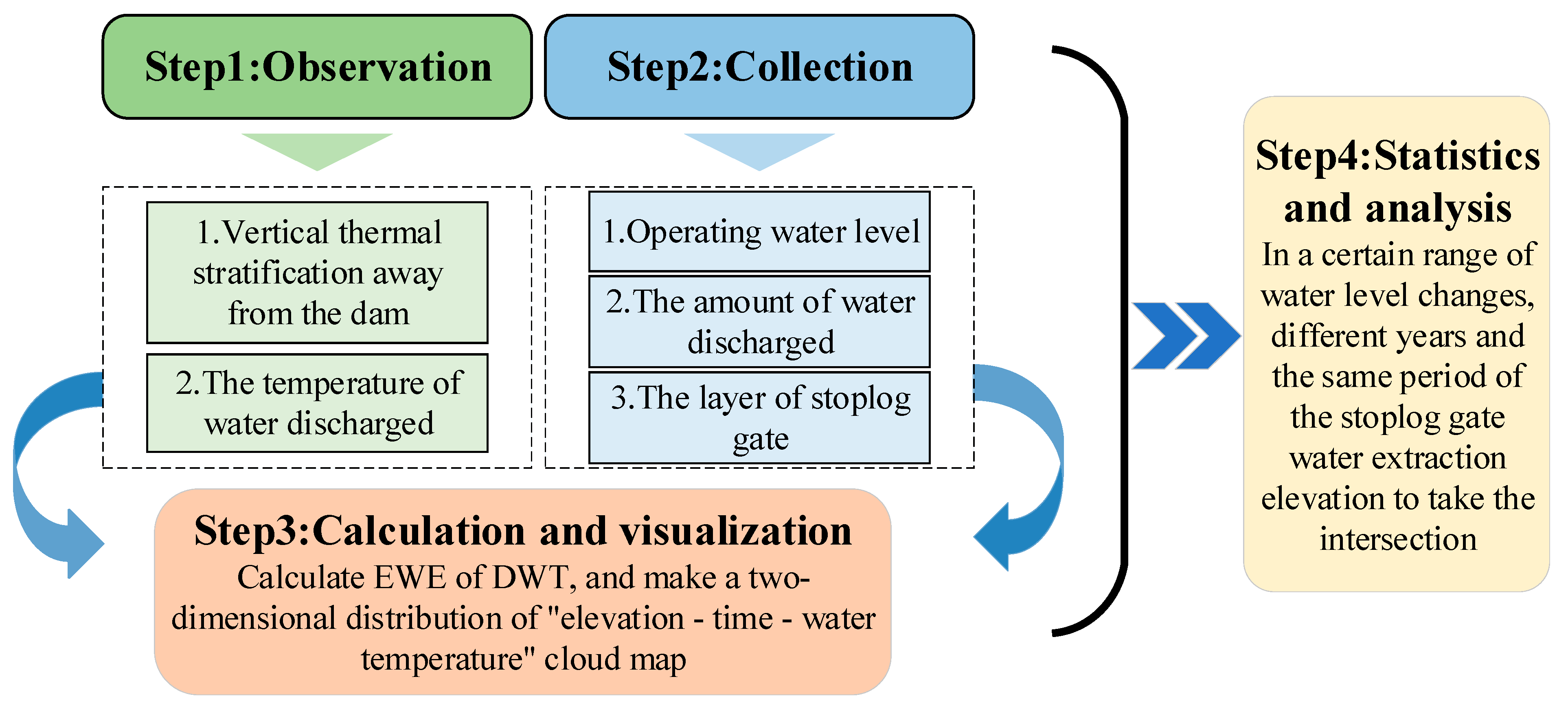
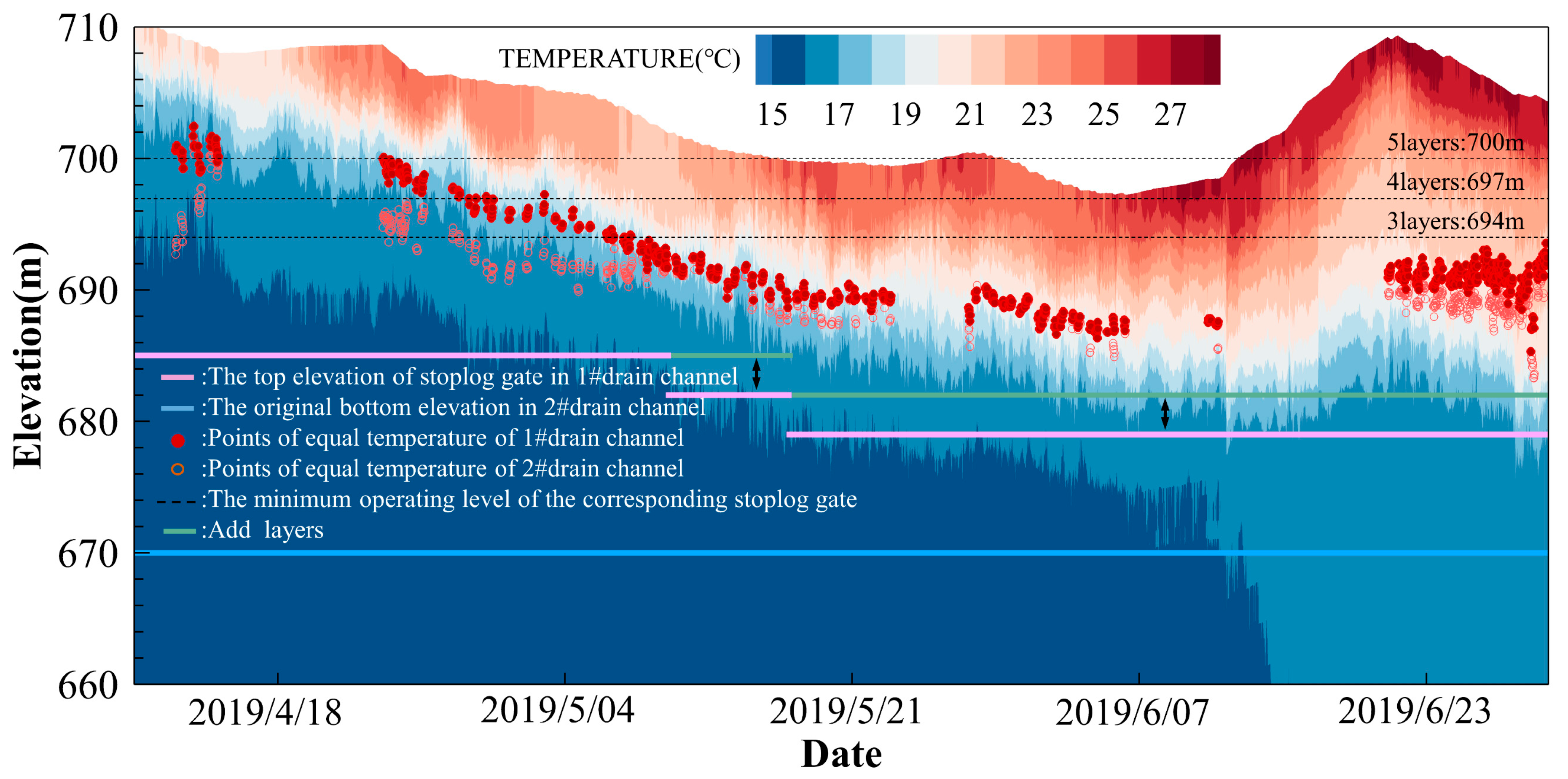
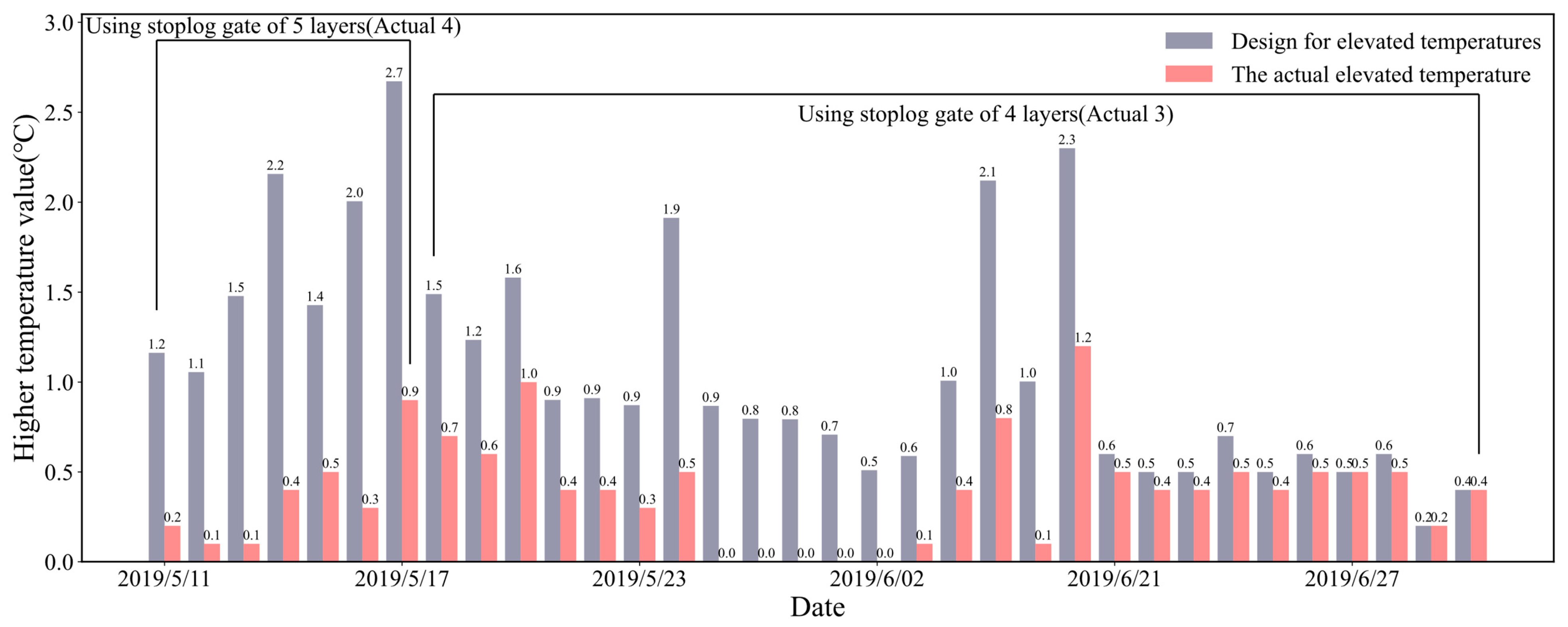
| Stoplog Gate Layer | Usage Time | Top Elevation of the Stoplog Gate | Minimum Operating Water Level | Range of Daily Average Reservoir Levels over the Service Life |
|---|---|---|---|---|
| 5 layers | 12 April–10 May 2019 | 685.00 m | 700.00 m | 703.3–710.3 m |
| 4 layers | 11 May–17 May 2019 | 682.00 m | 697.00 m | 700.9–702.8 m |
| 3 layers | 18 May–30 June 2019 | 679.00 m | 694.00 m | 698.3–709.2 m |
| Stoplog Gate Layer | Water Level | Average Abstraction Elevation with the Stoplog Gate | Average Temperature Gradient and Buoyancy Frequency | Average DWT (with the Stoplog Gate) | Average Abstraction Elevation without the Stoplog Gate | Average Temperature Gradient and Buoyancy Frequency | Average DWT (without the Stoplog Gate) |
|---|---|---|---|---|---|---|---|
| 5 layers | 711 m–709 m | 700.4 m | 0.33 °C/m 0.02 s−1 | 16.9 °C | 697.1 m | 0.12 °C/m 0.01 s−1 | 16.4 °C |
| 709 m–707 m | 697.8 m | 0.57 °C/m 0.03 s−1 | 17.8 °C | 693.9 m | 0.17 °C/m 0.01 s−1 | 16.6 °C | |
| 707 m–705 m | 695.4 m | 0.54 °C/m 0.03 s−1 | 18.0 °C | 692.1 m | 0.23 °C/m 0.02 s−1 | 16.9 °C | |
| 705 m–703 m | 693.1 m | 0.54 °C/m 0.03 s−1 | 18.2 °C | 691.7 m | 0.47 °C/m 0.03 s−1 | 17.6 °C | |
| 4 layers | 703 m–701 m | 690.8 m | 0.53 °C/m 0.03 s−1 | 18.4 °C | 690.1 m | 0.49 °C/m 0.03 s−1 | 18.0 °C |
| 3 layers | 701 m–699 m | 689.2 m | 0.53 °C/m 0.03 s−1 | 19.2 °C | 688.5 m | 0.52 °C/m 0.03 s−1 | 18.8 °C |
| 711 m–709 m | 691.3 m | 0.32 °C/m 0.03 s−1 | 20.4 °C | 689.7 m | 0.37 °C/m 0.03 s−1 | 19.9 °C | |
| 709 m–707 m | 691.4 m | 0.21 °C/m 0.02 s−1 | 20.9 °C | 689.2 m | 0.24 °C/m 0.02 s−1 | 20.5 °C | |
| 707 m–705 m | 690.7 m | 0.18 °C/m 0.02 s−1 | 21.4 °C | 688.6 m | 0.23 °C/m 0.02 s−1 | 21.0 °C |
Disclaimer/Publisher’s Note: The statements, opinions and data contained in all publications are solely those of the individual author(s) and contributor(s) and not of MDPI and/or the editor(s). MDPI and/or the editor(s) disclaim responsibility for any injury to people or property resulting from any ideas, methods, instructions or products referred to in the content. |
© 2023 by the authors. Licensee MDPI, Basel, Switzerland. This article is an open access article distributed under the terms and conditions of the Creative Commons Attribution (CC BY) license (https://creativecommons.org/licenses/by/4.0/).
Share and Cite
Liu, L.; Tuo, Y.; Xia, H.; Deng, Y.; Zhang, X.; Wang, H. Assessment of Stoplog Gates’ Operational Effectiveness for Improving Discharged-Water Temperatures during the Thermal Stratification Period in a Reservoir. Water 2023, 15, 4145. https://doi.org/10.3390/w15234145
Liu L, Tuo Y, Xia H, Deng Y, Zhang X, Wang H. Assessment of Stoplog Gates’ Operational Effectiveness for Improving Discharged-Water Temperatures during the Thermal Stratification Period in a Reservoir. Water. 2023; 15(23):4145. https://doi.org/10.3390/w15234145
Chicago/Turabian StyleLiu, Lijin, Youcai Tuo, Hao Xia, Yun Deng, Xu Zhang, and Haoyu Wang. 2023. "Assessment of Stoplog Gates’ Operational Effectiveness for Improving Discharged-Water Temperatures during the Thermal Stratification Period in a Reservoir" Water 15, no. 23: 4145. https://doi.org/10.3390/w15234145
APA StyleLiu, L., Tuo, Y., Xia, H., Deng, Y., Zhang, X., & Wang, H. (2023). Assessment of Stoplog Gates’ Operational Effectiveness for Improving Discharged-Water Temperatures during the Thermal Stratification Period in a Reservoir. Water, 15(23), 4145. https://doi.org/10.3390/w15234145





